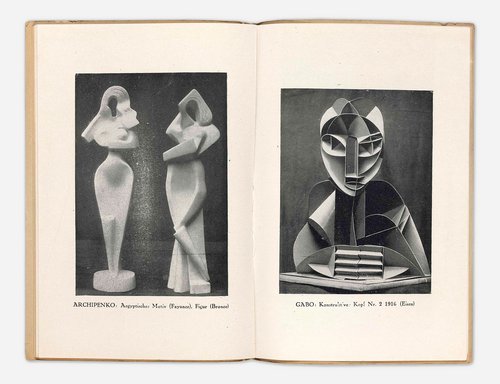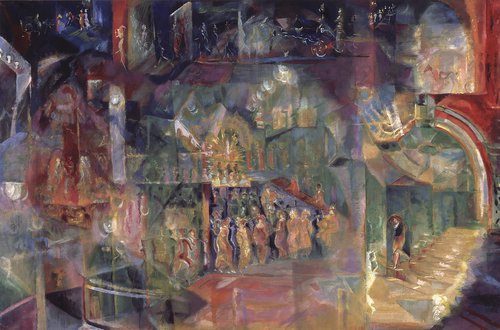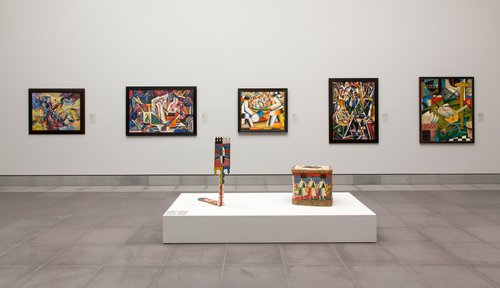Vladimir Tatlin. Model of the Tower of the Third International, 1920. Reconstructed in 1987–1991. Reconstructed by D. Dimakov, E. Lapshina, I. Fedotov. Reconstruction author: D. Dimakov. Photo by Mikhail Vilchuk. Courtesy of Zotov Centre
Tatlin, the Telnyashka Gentleman
A new retrospective at the Zotov Centre in Moscow celebrates the 140th anniversary of Vladimir Tatlin’s birth and 105 years since his iconic ‘Tower of the Third International’. This exhibition reveals the fascinating contradictions of the Soviet avant-garde’s most enigmatic figure.
Vladimir Tatlin (1885–1953) is one of the most famous Russian artists of the first half of the 20th century. Three of his inventions, counter-reliefs, the Tower of the Third International and Letatlin shaped the international image of the Soviet avant-garde. An exhibition called ‘Tatlin. Construction of the World’ is currently on show at the Zotov Centre in Moscow to celebrate the 140th anniversary of the artist’s birth as well as the third anniversary of the centre itself.And there is a third anniversary: it is 105 years since the construction of the first model of the ‘Tower of the Third International’, first shown to the public on 8 November 1920. The exhibition design is by Yury Avvakumov (b. 1957) and there is a monumental catalogue accompanying the exhibition created by Mikhail Anikst (b. 1938), one of the finest Russian book designers of the second half of the 20th and beginning of the 21st century.
Vladimir Tatlin's life story was as fortunate as could be for an artist of the Russian avant-garde. He did not die of starvation in the Siege of Leningrad as did his contemporary Pavel Filonov (1883–1941). He was not arrested by the NKVD like Kazimir Malevich (1879–1935). He was not forced to leave Russia without the possibility of return, like Wassily Kandinsky (1866–1944). He was not expelled from the Union of Artists like Alexander Rodchenko (1891–1956).
From the very beginning when he set out as a young artist Vladimir Tatlin was an exception to the general rule. Firstly, he was from the nobility (less than ten percent of artists of the avant-garde were from this stratum of society, at the time one percent of the population). But at the same time, he was an extremely poor and not well educated: initially he did not finish his secondary school education, although he later managed to complete the full course of the provincial Penza Art School. He left home whilst still a teenager which his father was still alive, and later after the death of his father in 1904 – and the death of his uncle in 1912 – Tatlin lived for several years half-starved, in slums.
In fact, his first real success in art were his counter-reliefs which owed their appearance to poverty. Artist Valentina Khodasevich (1894–1970) recalled how even before the First World War Tatlin tried without success to make his own pastels in a workshop on Ostozhenka Street so he did not have to buy them in a shop. In this same place, on Ostozhenka Street, he opened the first exhibition of his painterly reliefs. And for the group exhibition of Futurists ‘Tram V’ in Petrograd (formerly St. Petersburg) in 1915, he made works out of junk which he found in the basement flat of Valentina Khodasevich’s husband. Thus, a completely new unprecedented art form was created from pieces of glass, scraps of sheet iron, wire, blocks, and crumpled paper... “An exit beyond the canvas”, as the critic Nikolai Punin described it. Neither painting nor sculpture... Counter-relief!
What distinguished Tatlin even more from his contemporaries is that he was a sailor. Amongst blue-chip Russian artists, men of the sea are few and far between. In the 19th century there was naval officer Alexei Bogoliubov (1824–1896), avant-gardist marine Pavel Filonov (1883–1941), ‘Red sailor’ Fyodor Bogorodsky (1895–1959) amongst the socialist realists, and today merchant navy sailor Alexander Ponomarev (b. 1957). Tatlin managed to wander as a cabin boy between school and art college across seas and waves, and regularly signed up as a sailor for voyages whilst committing to exhibitions, an exceptionally rare biography for a person of his social standing – not the privileged Naval Cadet Corps or the prestigious Naval Engineering School, but downright hard work in a dirty telnyashka (ed. A seaman’s striped long sleeved teeshirt). His 1911 painting ‘Sailor’ is canonical, an ironic self-portrait from the State Russian Museum, and one of his first theatrical works was the set designs for Richard Wagner’s opera ‘The Flying Dutchman’ (in 1915 and 1918). It is obvious that this was a complete cycle of sketches, not intended for production, since Russia was at war with Germany in the First World War, and Wagner's operas were not staged in Russia due to anti-German sentiments. The October Revolution of 1917 romanticised the figure of the sailor, and Tatlin, who loved to wear a telnyashka, fitted in.
Soviet power brought Tatlin not only fame but also prosperity. As the artist Vera Pestel (1887–1952) recalled, “Tatlin, who previously went around in winter and summer wearing in an old grey cloth coat, without gloves and all year the same stiff felt hat now had a workshop and was dressed in a fur coat, a doha with a fur collar. On his head he had a fur hat with ears, and valenki”. In 1918, Tatlin became a new art chief: from April 1918 to May 1919 he served as Chairman of the Moscow Art Board of IZO Narkompros, distributing money and commissions amongst old comrades from the avant-garde, and also determined which works state museums should acquire during the most difficult period of famine and devastation. Moreover, Tatlin was one of the organisers, and at the end of 1918, the first chairman of the purchasing commission of the Museum of Pictorial Culture – the world’s first contemporary art museum.
According to family legend, the Tatlins are descendants of a Dutch shipbuilder called Van Tatling who came to Russia at the invitation of Peter the Great. Vladimir Tatlin – tall, broad-shouldered, big-nosed, blue-eyed, fair-haired (almost albino), with enormous red hands – conformed 100% to the Russian ethnic stereotype of a Dutchman: clumsy but deft-handed. He believed that art was “a thing made skilfully” (according to the artist Valentin Kurdov (1905–1989)). And his contemporaries often perceived him as a craftsman. And his new system of art education, based on the cult of things and the culture of materials, returned to guild training, where the master and apprentices work together on a commission, mastering the forms of things, raw materials for their manufacture and working techniques.
The ‘Tower of the Third International’ became a symbol of new art and has remained so for over a century, because Tatlin used the motif of the Tower of Babel, reworking it into a sign of revolution. The main difference between the new project and the biblical prototype, which was emphasised by the tower’s first propagandist, Nikolai Punin, is dynamism. But the paradox is that the tower never moved: after all, its internal volumes, which were supposed to rotate in synchrony with the movement of days, months and years, did not rotate in any of its models.
The problems of Tatlinism are obvious. The artist called for the power of engineers in art, but he himself could not master even a complete school technical course, let alone theory of the strength of different materials. And so, his projects for machines and buildings are fantasies, not solutions. The ‘Tower of the Third International’ is not an architectural project, but a visionary one: Tatlin proposed a model, but not a construction (which, in his opinion, should have been created by bridge builders). ‘Letatlin’ – his ornithopter project – was tested by professional aviators: one of the most curious documents at the new exhibition is the flight test protocol with the signature of Konstantin Artseulov, one of the first Russian pilots, a gliding pioneer, inventor of the controlled spin (an aerobatic figure) and grandson of the artist Ivan Aivazovsky (1817–1900). But ‘Letatlin’ remained closer to the Russian fairy tale ‘The Wooden Eagle’ than to any realistic prototype. The construction is scenic, not practical.
Demanding the production of new things, Tatlin understood that in the Russia of his time there was no material base for this. In his 1929 article ‘The Artist as Organiser of Everyday Life’ (one of the few texts written by him), he wrote: “Everything that is being done in our country now in the field of constructing new furniture is merely an attempt to imitate the West. There is now a great vogue for furniture reform through constructing it from bicycle tubing. There were attempts here too to follow this path. But here we encountered a shortage of the material itself – iron tubes”. In early 20th-century Russia you could not even buy locally made artist paints for use at home, only imported ones were available.
It is hard work to create an exhibition about Tatlin. Back in the 1960s, when Swedish curator Pontus Hultén headed the Moderna Museet in Stockholm, he tried to track down Tatlin’s works, but as Yury Avvakumov, designer of the exhibition at Zotov, explains he discovered that the artist had been forgotten in his homeland, and few of his works had survived.
Exhibitions about Tatlin rely on reconstructions, a tradition that Hultén established. Thanks to him, new models of the ‘Tower of the Third International’ began to spring up around the world. The original models have not survived, like the majority of the artist’s most innovative works. However, the corner counter-relief of 1915 is in the collection of the State Russian Museum, although absent from the Zotov exhibition (a curious detail of the monumental 464-page catalogue accompanying the new exhibition is the absence of a good quality colour photograph of this work, as though an academic catalogue about Leonardo da Vinci had not included a photograph of the ‘Mona Lisa’). There is another known authentic counter-relief in the State Tretyakov Gallery, also absent from the Zotov show. All of Tatlin’s counter-reliefs at Zotov are reproductions created from old black-and-white photographs where it is often difficult to establish even the materials originally used, and dimensions are approximated. That is, Tatlin’s assemblages and architectural models are contemporary pastiches. One of his major masterpieces, the ‘Letatlin’, has been the subject of long running disputes between museums. It was exhibited at the Tretyakov Gallery for many years, until last year it returned to the State Museum of the Air Force (who are lending it to the Zotov show).
The Tatlin originals that have come down to us generally do not create the impression that he was a master of the avant-garde. The few painterly works and drawings of the pre-revolutionary period show him rather as an imitator, dependent more on Mikhail Larionov (1881–1964) than on Western European Cubism. His late still lifes, portraits and landscape sketches for theatrical backdrops of the 1940s and 1950s reveal that the artist admired the Spanish old masters in his later years, above all Diego Velázquez (1599–1960) and Francisco de Zurbarán (1598–1964), and the ‘dark manner’ became his guiding star in the last period of his life.
In 1931 Vladimir Tatlin received the honorary state title of ‘Honoured Art Worker’. In 1932 he had a solo exhibition at the State Museum of Fine Arts in Moscow. In 1934 he took part in a trip for writers and artists along the White Sea Canal (de facto, advertising for the Gulag). In 1935 he was given his own workshop on Maslovka, in the Artists’ Town, next to revered masters of socialist realism. In 1937 he became chief artist of the ‘Animal Husbandry’ pavilion at the Exhibition of Achievements of the National Economy (VDNKh), the official showcase of Soviet industry and collective farming.
Throughout the 1930s and 1940s Vladimir Tatlin designed theatrical productions with some success. In 1944 his book ‘The Moon on Stage’ came off the press, his last publication, and oddly enough, it is precisely Tatlin’s Moon for the techniques of illusionistic lighting and arrangement of sets, that is closer to contemporary Russian art in the 2020s than his visionary avant-garde projects.




















